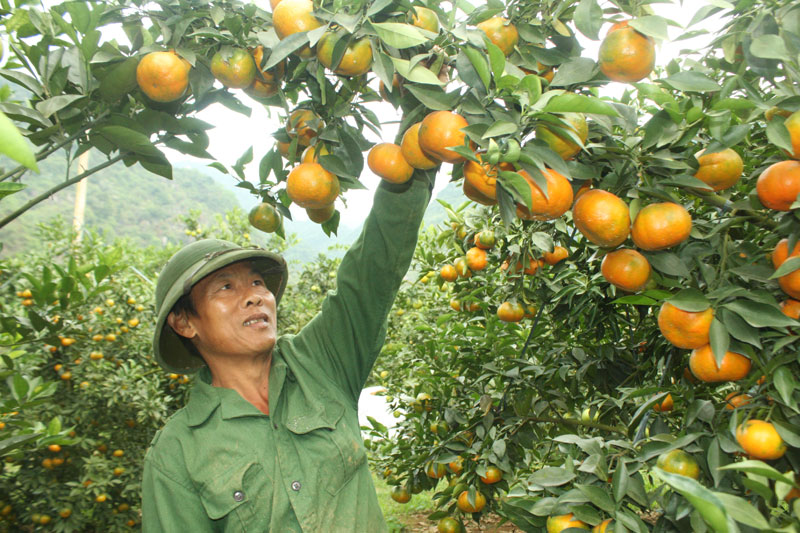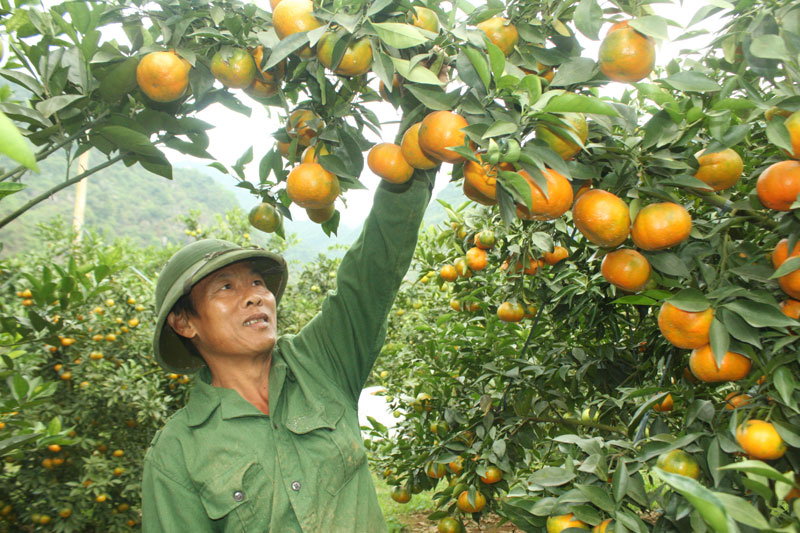
(HBO) – Over the past five years, My Hoa commune of Kim Boi district, Hoa Binh province stepped up economic structure transfer, focusing on citrus trees which are now growing rapidly, initially bringing positive outcomes and raising hope for a better life of locals.
The five-year-old orange orchard is expected to generate big income for the family of Vu Xuan Dang in Dong Da hamlet, My Hoa commune, Kim Boi district
Ha Cong Tien, Vice Chairman of the communal People’s Committee, said that orange and pomelo trees have been revitalized in My Hoa after they are added to the citrus planting area in 2013. Total area of citrus trees in My Hoa stands at 197ha, with 112ha of orange and the remaining for green-skin and red-fleshed grapefruits. Thanks to suitable soil and hardworking farmers, orange and pomelo trees have yielded fruits after five years.
Local farmers have land while businesses and the private sector contribute varieties, capital, technologies and farming experience. Therefore, cooperation between locals and businesses in Dong Ha has brought about tangible benefits. We felt dizzy when seeing orchards of orange trees weighted down with fruits although they are just five years old.
Chu Van Duong, head of Dong Ha hamlet, who took us to orange orchards, said up to 40 out of 46 households in the hamlet have planted orange trees with most of the orchards reaching 4-5 years. Last year, many orchards began to bear fruits. This year, 30 households have officially harvested orange. Each household in the hamlet own about 1ha of land. Moreover, most of locals used to work in the Thanh Ha farm, so they have some experience in orange planting. Many traders are coming to buy orange. A number of them even asked to buy the whole orchard. Canh orange price increased from 20,000 VND per kg to 30,000 VND this year. The price of V2 orange also climbed from 30,000 VND per kg in the previous season to 35,000-40,000 VND this year.
like other farmers in Dong Ha hamlet, happiness can be seen on the face of Vu Xuan Dang, who has joined hands with private businesses to plant orange trees on an area of 1.6 ha over the past five years. Last year, he collected more than 20 tonnes of orange. This year, the output is expected to be much higher as each Canh orange tree can bear 50-70 fruits.
"Many people visiting my orchard don’t think that it is just five years old as many trees look as if they have been planted for 8-10 years,” he said.
Next to Dang’s orchard is that of Lo Van Huu which is hoped to break even this year although orange cultivation requires a big amount of money. To gain sustainable outcomes, Huu and other farmers in My Hoa commune have registered to participate in safe production model in line with VietGap standards.
My Hoa still has about 100ha of land favourable for citrus planting, which could bring about high economic benefits to locals with support in sales./.
According to data from the Hoa Binh Provincial Party Committee, the industrial production index for the first six months of 2025 is estimated to have increased by 20% compared to the same period last year. This marks the highest year-on-year growth rate for this period since 2020.
In the first six months of 2025, Hoa Binh province’s export turnover was estimated at 1.145 billion USD, marking an 18.11% increase compared to the same period in 2024. Import turnover was estimated at $ 804 million, a 17.15% increase, which helped the province maintain a positive trade balance.
The lives of the ethnic minority farmers in Tan Lac district have gradually improved thanks to the new directions in agricultural production. This is a testament to the collective strength fostered through the professional associations and groups implemented by various levels of the district’s Farmers’ Union.
With the motto the "product quality comes first,” after nearly one year of establishment and operation, Muong village’s Clean Food Agricultural and Commercial Cooperative, located in Cau Hamlet, Hung Son Commune (Kim Boi district), has launched reputable, high-quality agricultural products to the market that are well-received by consumers. The products such as Muong village’s pork sausage, salt-cured chicken, and salt-cured pork hocks have gradually carved out a place in the market and they are on the path to obtaining the OCOP certification.
In the past, the phrase "bumper harvest, rock-bottom prices" was a familiar refrain for Vietnamese farmers engaged in fragmented, small-scale agriculture. But today, a new spirit is emerging across rural areas of Hoa Binh province - one of collaboration, organisation, and collective economic models that provide a stable foundation for production.
Maintaining growing area codes and packing facility codes in accordance with regulations is a mandatory requirement for agricultural products to be eligible for export. Recently, the Department of Agriculture and Environment of Hoa Binh province has intensified technical supervision of designated farming areas and packing facilities to safeguard the "green passport" that enables its products to access international markets.



